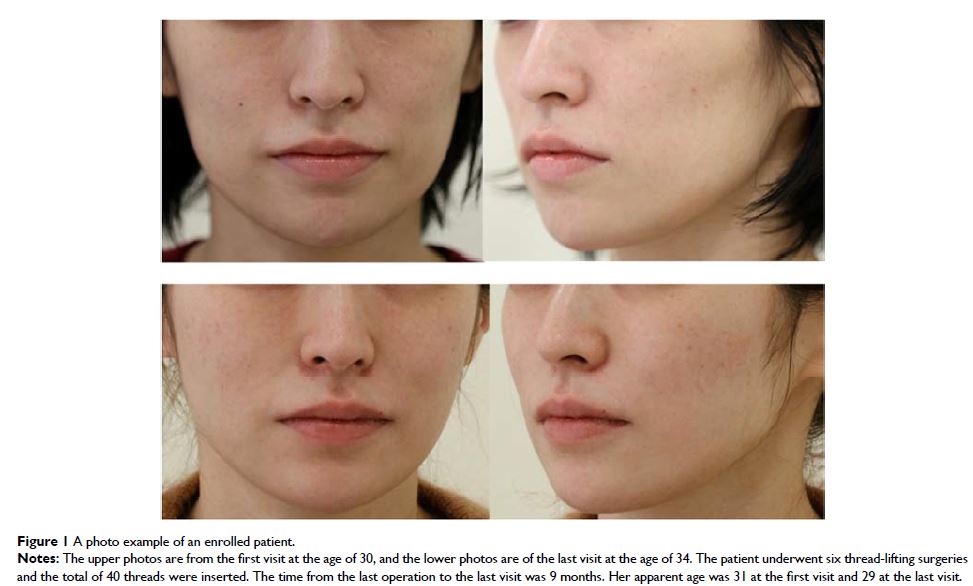108384
论文已发表
注册即可获取德孚的最新动态
IF 收录期刊
- 3.4 Breast Cancer (Dove Med Press)
- 3.2 Clin Epidemiol
- 2.6 Cancer Manag Res
- 2.9 Infect Drug Resist
- 3.7 Clin Interv Aging
- 5.1 Drug Des Dev Ther
- 3.1 Int J Chronic Obstr
- 6.6 Int J Nanomed
- 2.6 Int J Women's Health
- 2.9 Neuropsych Dis Treat
- 2.8 OncoTargets Ther
- 2.0 Patient Prefer Adher
- 2.2 Ther Clin Risk Manag
- 2.5 J Pain Res
- 3.0 Diabet Metab Synd Ob
- 3.2 Psychol Res Behav Ma
- 3.4 Nat Sci Sleep
- 1.8 Pharmgenomics Pers Med
- 2.0 Risk Manag Healthc Policy
- 4.1 J Inflamm Res
- 2.0 Int J Gen Med
- 3.4 J Hepatocell Carcinoma
- 3.0 J Asthma Allergy
- 2.2 Clin Cosmet Investig Dermatol
- 2.4 J Multidiscip Healthc

已发表论文
Long-term effect of the insoluble thread-lifting technique
Authors Fukaya M
Received 3 September 2017
Accepted for publication 22 October 2017
Published 14 November 2017 Volume 2017:10 Pages 483—491
DOI https://doi.org/10.2147/CCID.S150738
Checked for plagiarism Yes
Review by Single-blind
Peer reviewers approved by Dr Colin Mak
Peer reviewer comments 2
Editor who approved publication: Dr Jeffrey Weinberg
Background: Although the
thread-lifting technique for sagging faces has become more common and popular,
medical literature evaluating its effects is scarce. Studies on its long-term
prognosis are particularly uncommon.
Patients and methods: One hundred individuals who had previously undergone insoluble thread-lifting were retrospectively investigated. Photos in frontal and oblique views from the first and last visits were evaluated by six female individuals by guessing the patients’ ages. The mean guessed age was defined as the apparent age, and the difference between the real and apparent ages was defined as the youth value. The difference between the youth values before and after the thread-lift was defined as the rejuvenation effect and analyzed in relation to the time since the operation, the number of threads used and the number of thread-lift operations performed.
Results: The rejuvenation effect decreased over the first year after the operation, but showed an increasing trend thereafter. The rejuvenation effect increased with the number of threads used and the number of thread-lift operations performed.
Conclusion: The insoluble thread-lifting technique appears to be associated with both early and late effects. The rejuvenation effect appeared to decrease during the first year, but increased thereafter. A multicenter trial is necessary to confirm these findings.
Keywords: insoluble thread, Aptos, thread-lift, Xtosis, Aptos spring
Patients and methods: One hundred individuals who had previously undergone insoluble thread-lifting were retrospectively investigated. Photos in frontal and oblique views from the first and last visits were evaluated by six female individuals by guessing the patients’ ages. The mean guessed age was defined as the apparent age, and the difference between the real and apparent ages was defined as the youth value. The difference between the youth values before and after the thread-lift was defined as the rejuvenation effect and analyzed in relation to the time since the operation, the number of threads used and the number of thread-lift operations performed.
Results: The rejuvenation effect decreased over the first year after the operation, but showed an increasing trend thereafter. The rejuvenation effect increased with the number of threads used and the number of thread-lift operations performed.
Conclusion: The insoluble thread-lifting technique appears to be associated with both early and late effects. The rejuvenation effect appeared to decrease during the first year, but increased thereafter. A multicenter trial is necessary to confirm these findings.
Keywords: insoluble thread, Aptos, thread-lift, Xtosis, Aptos spring
